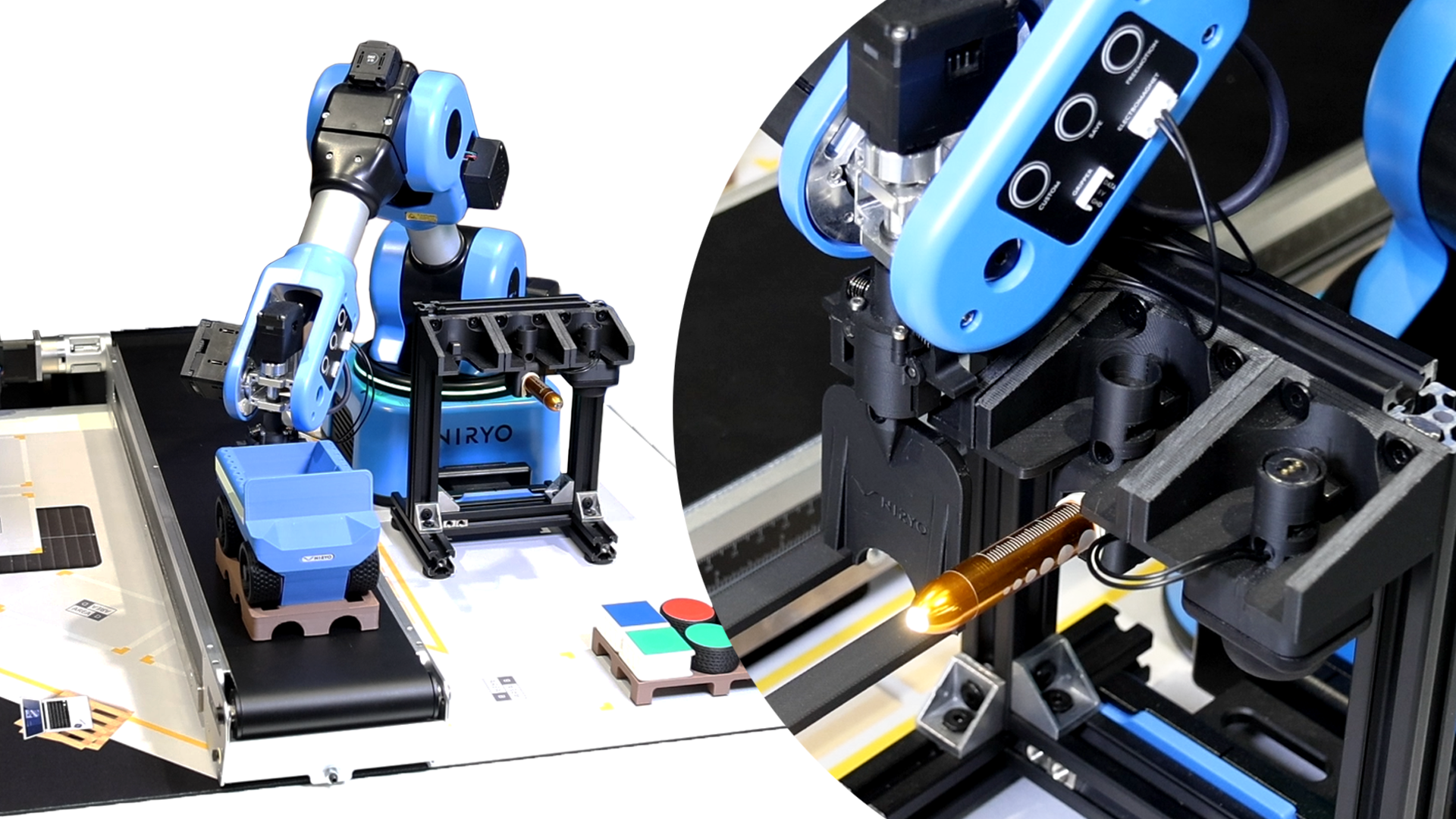About the course
Robotic tool-changing systems have become a key enabler of flexibility and efficiency in industrial automation and robotics. By allowing a single robot to switch between different end-effectors or tools autonomously, these systems reduce downtime, enhance adaptability, and support complex multi-step processes. Inspired by CNC machining centers, modern robotic tool changers incorporate mechanical, electrical, and sometimes pneumatic coupling mechanisms to ensure rapid and reliable transitions.
In this project, students will design, assemble, and program a quick tool changer for the Niryo Ned2 robot. The quick tool changer allows the robot to automatically switch between different tools (such as a fork, pen holder, or electromagnet), making it more versatile for automation tasks.
Through a combination of mechanical assembly, electronics, soldering, 3D printing, and programming, students will gain hands-on experience in building a functional robotic accessory from start to finish.
This project bridges mechanical engineering, electronics, and computer science, providing a real-world learning experience similar to industrial robotics integration.
By completing this project, students will:
-
Robotics & Mechatronics
-
Understand the role of quick tool changers in industrial robotics.
-
Learn how to integrate mechanical, electrical, and software systems in a robotic environment.
-
-
Mechanical Skills
-
Assemble mechanical components, including 3D-printed parts and locking mechanisms.
-
Adjust tolerances, orientation, and printing parameters to ensure functional fits.
-
-
Electronics & Wiring
-
Wire and solder connectors (JST, plugs, cables) safely and accurately.
-
Verify electrical connections with a multimeter to prevent short circuits.
-
-
3D Printing & Design
-
Use 3D-printed custom parts (lever, lock, cover, adaptors) in robotic assemblies.
-
Apply design-for-assembly concepts, such as orientation and post-processing (sanding).
-
-
Programming & Control
-
Configure NiryoStudio to recognize and switch tools.
-
Write simple Blockly programs to automate tool changes.
-
-
Problem-Solving & Safety
-
Identify and correct common issues (tolerances, misalignment, electrical errors).
-
Apply safe practices in assembly, wiring, and robot operation.
-
What you'll learn
- Understand quick tool changers in industrial robotics.
- Integrate mechanical, electrical, and software systems.
- Assemble 3D-printed parts and mechanical locking systems.
- Adjust tolerances and printing parameters for proper fit.
- Wire and solder JST connectors, plugs, and cables.
- Verify connections with a multimeter to prevent shorts.
- Use 3D-printed components in robotic assemblies.
- Apply design-for-assembly and post-processing techniques.
- Configure NiryoStudio for automatic tool recognition.
- Write Blockly programs to automate tool changes.
- Troubleshoot alignment, tolerance, and wiring issues.
- Apply safe practices in assembly and robot operation
Course content
About the Author
Enrolment options
Project Lab: Designing an Autonomous Tool Changer
- Length: 20h
- Content Type: Project
- Programming: Blockly
- Equipment: Bundle STEM
Robotic tool-changing systems have become a key enabler of flexibility and efficiency in industrial automation and robotics. By allowing a single robot to switch between different end-effectors or tools autonomously, these systems reduce downtime, enhance adaptability, and support complex multi-step processes. Inspired by CNC machining centers, modern robotic tool changers incorporate mechanical, electrical, and sometimes pneumatic coupling mechanisms to ensure rapid and reliable transitions.
In this project, students will design, assemble, and program a quick tool changer for the Niryo Ned2 robot. The quick tool changer allows the robot to automatically switch between different tools (such as a fork, pen holder, or electromagnet), making it more versatile for automation tasks.
Through a combination of mechanical assembly, electronics, soldering, 3D printing, and programming, students will gain hands-on experience in building a functional robotic accessory from start to finish.
This project bridges mechanical engineering, electronics, and computer science, providing a real-world learning experience similar to industrial robotics integration.
By completing this project, students will:
-
Robotics & Mechatronics
-
Understand the role of quick tool changers in industrial robotics.
-
Learn how to integrate mechanical, electrical, and software systems in a robotic environment.
-
-
Mechanical Skills
-
Assemble mechanical components, including 3D-printed parts and locking mechanisms.
-
Adjust tolerances, orientation, and printing parameters to ensure functional fits.
-
-
Electronics & Wiring
-
Wire and solder connectors (JST, plugs, cables) safely and accurately.
-
Verify electrical connections with a multimeter to prevent short circuits.
-
-
3D Printing & Design
-
Use 3D-printed custom parts (lever, lock, cover, adaptors) in robotic assemblies.
-
Apply design-for-assembly concepts, such as orientation and post-processing (sanding).
-
-
Programming & Control
-
Configure NiryoStudio to recognize and switch tools.
-
Write simple Blockly programs to automate tool changes.
-
-
Problem-Solving & Safety
-
Identify and correct common issues (tolerances, misalignment, electrical errors).
-
Apply safe practices in assembly, wiring, and robot operation.
-
- Enrolled students: 31




